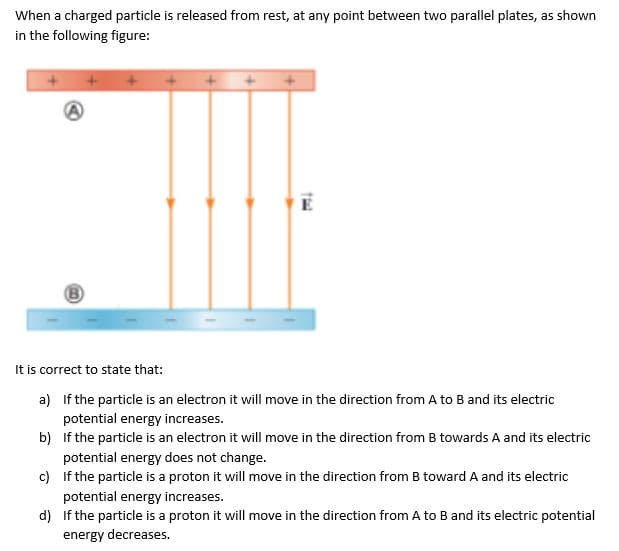When a charged particle is released from rest, at any point between two parallel plates, as shown in the following figure: It is correct to state that: a) If the particle is an electron it will move in the direction from A to B and its electric potential energy increases. b) If the particle is an electron it will move in the direction from B towards A and its electric potential energy does not change. c) If the particle is a proton it will move in the direction from B toward A and its electric potential energy increases. d) If the particle is a proton it will move in the direction from A to B and its electric potential energy decreases.
When a charged particle is released from rest, at any point between two parallel plates, as shown in the following figure: It is correct to state that: a) If the particle is an electron it will move in the direction from A to B and its electric potential energy increases. b) If the particle is an electron it will move in the direction from B towards A and its electric potential energy does not change. c) If the particle is a proton it will move in the direction from B toward A and its electric potential energy increases. d) If the particle is a proton it will move in the direction from A to B and its electric potential energy decreases.
Principles of Physics: A Calculus-Based Text
5th Edition
ISBN:9781133104261
Author:Raymond A. Serway, John W. Jewett
Publisher:Raymond A. Serway, John W. Jewett
Chapter20: Electric Potential And Capacitance
Section: Chapter Questions
Problem 7CQ
Related questions
Concept explainers
Dielectric Constant Of Water
Water constitutes about 70% of earth. Some important distinguishing properties of water are high molar concentration, small dissociation constant and high dielectric constant.
Electrostatic Potential and Capacitance
An electrostatic force is a force caused by stationary electric charges /fields. The electrostatic force is caused by the transfer of electrons in conducting materials. Coulomb’s law determines the amount of force between two stationary, charged particles. The electric force is the force which acts between two stationary charges. It is also called Coulomb force.
Question

Transcribed Image Text:When a charged particle is released from rest, at any point between two parallel plates, as shown
in the following figure:
E
It is correct to state that:
a) If the particle is an electron it will move in the direction from A to B and its electric
potential energy increases.
b) If the particle is an electron it will move in the direction from B towards A and its electric
potential energy does not change.
c) If the particle is a proton it will move in the direction from B toward A and its electric
potential energy increases.
d) If the particle is a proton it will move in the direction from A to B and its electric potential
energy decreases.
Expert Solution
This question has been solved!
Explore an expertly crafted, step-by-step solution for a thorough understanding of key concepts.
Step by step
Solved in 2 steps

Knowledge Booster
Learn more about
Need a deep-dive on the concept behind this application? Look no further. Learn more about this topic, physics and related others by exploring similar questions and additional content below.Recommended textbooks for you

Principles of Physics: A Calculus-Based Text
Physics
ISBN:
9781133104261
Author:
Raymond A. Serway, John W. Jewett
Publisher:
Cengage Learning

College Physics
Physics
ISBN:
9781305952300
Author:
Raymond A. Serway, Chris Vuille
Publisher:
Cengage Learning

Physics for Scientists and Engineers: Foundations…
Physics
ISBN:
9781133939146
Author:
Katz, Debora M.
Publisher:
Cengage Learning

Principles of Physics: A Calculus-Based Text
Physics
ISBN:
9781133104261
Author:
Raymond A. Serway, John W. Jewett
Publisher:
Cengage Learning

College Physics
Physics
ISBN:
9781305952300
Author:
Raymond A. Serway, Chris Vuille
Publisher:
Cengage Learning

Physics for Scientists and Engineers: Foundations…
Physics
ISBN:
9781133939146
Author:
Katz, Debora M.
Publisher:
Cengage Learning


Physics for Scientists and Engineers
Physics
ISBN:
9781337553278
Author:
Raymond A. Serway, John W. Jewett
Publisher:
Cengage Learning

Physics for Scientists and Engineers with Modern …
Physics
ISBN:
9781337553292
Author:
Raymond A. Serway, John W. Jewett
Publisher:
Cengage Learning